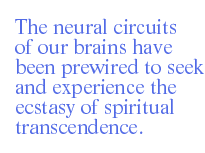
Christianity has a unique creation story about a primeval Eden that ended with original sin, exile, suffering and death. Too many Christian theologians, and most laity, have linked Adam and Eve's original sin with sex. None of the Eastern religions believe in an "original sin" or link creation, evil and death with sex.
Add to this fall from primeval innocence the disastrous influence of the Persian Zoroastrian view of a world of light and spirit created by a good god and a world of darkness, matter, body and sex created by an evil god. This ancient dualistic view has repeatedly surfaced in various Christian disguises: Gnostic, Manichean, Albigensian, Cathar, Jansenist, Puritan and Victorian. Add a second pagan factor, advocated by the followers of Plato, that splits human nature into a divine spirit imprisoned in a material body. Christian thinkers adopted this view to celebrate the superiority of male rationality while condemning women as the emotional, sensual "outpost of Hell." "Nothing so quickly brings a man down from his noble height," they wrote, "as the fondling of women and those touches associated with marriage. Flee all pleasure!" Sermons celebrating responsible sensual and erotic pleasure are a true rarity.
Besides, the gods and goddesses of Eastern religions are often shown in sexual embraces, yabyum. Hindu polytheism, with Shiva representing the masculine, passive, transcendent, eternal principle and Shakti, the Divine Mother, symbolizing the feminine, active, immanent, temporal principle, celebrates sexual pleasure as one of several paths to the spiritual. Christianity's asexual (somehow masculine) God is a jealous God who requires monogamy and accepts the Virgin Mary as the model of women.
For me, sex and spirit are both facets of being human. Focusing on our bodies, senses and sexuality puts us at risk of being locked into and limited by sensual addiction if our spiritual side does not challenge us to move beyond the joys and pleasures of our senses to other persons, and to the Ultimate. On the other hand, any religion or spiritual view that denies the value and pleasures our senses and sexual intimacies bring us in fact denies that everything we know about the world and an Ultimate Being comes to us through the windows of our senses and their pleasures.
Spirit Thousands of years before our earliest written religious texts, our Cro-Magnon and Neanderthal ancestors ritually buried their dead in hopes of a life hereafter, leaving us powerful relics of their human search for a deeper spiritual meaning of life. The neural circuits of our brains have been prewired to seek and experience the ecstasy of spiritual transcendence and union with the One.
Sex Even more ancient are the biological roots of our sexuality. Our skin, like the skin of all our ancestors back to the earliest warm-blooded mammals, craves and thrives on the nurturing, sensual pleasures of touch and cuddling. The ancient pleasure centers of our emotional (limbic) brain have been wired to respond to nurturing sensual touch and the ecstatic pleasures of erotic, orgasmic explosions. Our sensual, erotic, passionate needs cannot be denied unless we get rid of our bodies and our brains.
The challenge of Sex and Spirit have coexisted for as long as humans have been human. Connecting them has never been easy, especially for Christianity. Bernini captures the ecstasy and passion of this union in his statue in the Vatican of an angel piercing the Spanish mystic Teresa of Avila with a golden shaft dripping the dew of divine love, echoing Teresa's own account of her mystical encounter with her Beloved. Teresa's friend, John of the Cross, has given us a male version of sex and spirit rejoined. Hieronymus Bosch (c.1500) has given us a sex and spirit picture of Eden. The Pre-Raphaelite Dante Gabriel Rossetti, England's great visionary poet, William Blake, and the love poems of the Muslim Sufi mystic Rumi have also celebrated the union of sex and spirit, but they are far too few in the overwhelming anti-sexual West.
Moore responds
|
|


